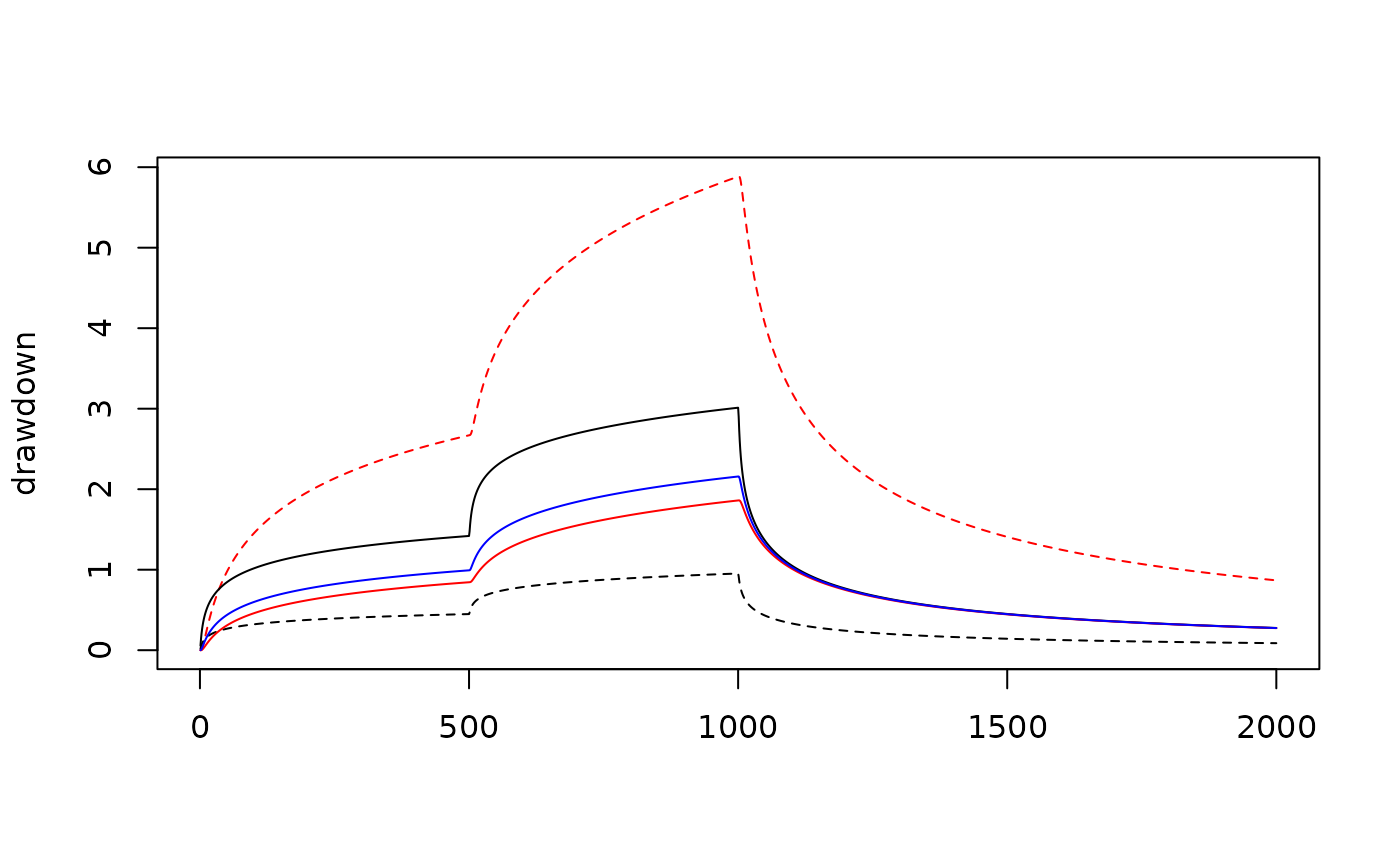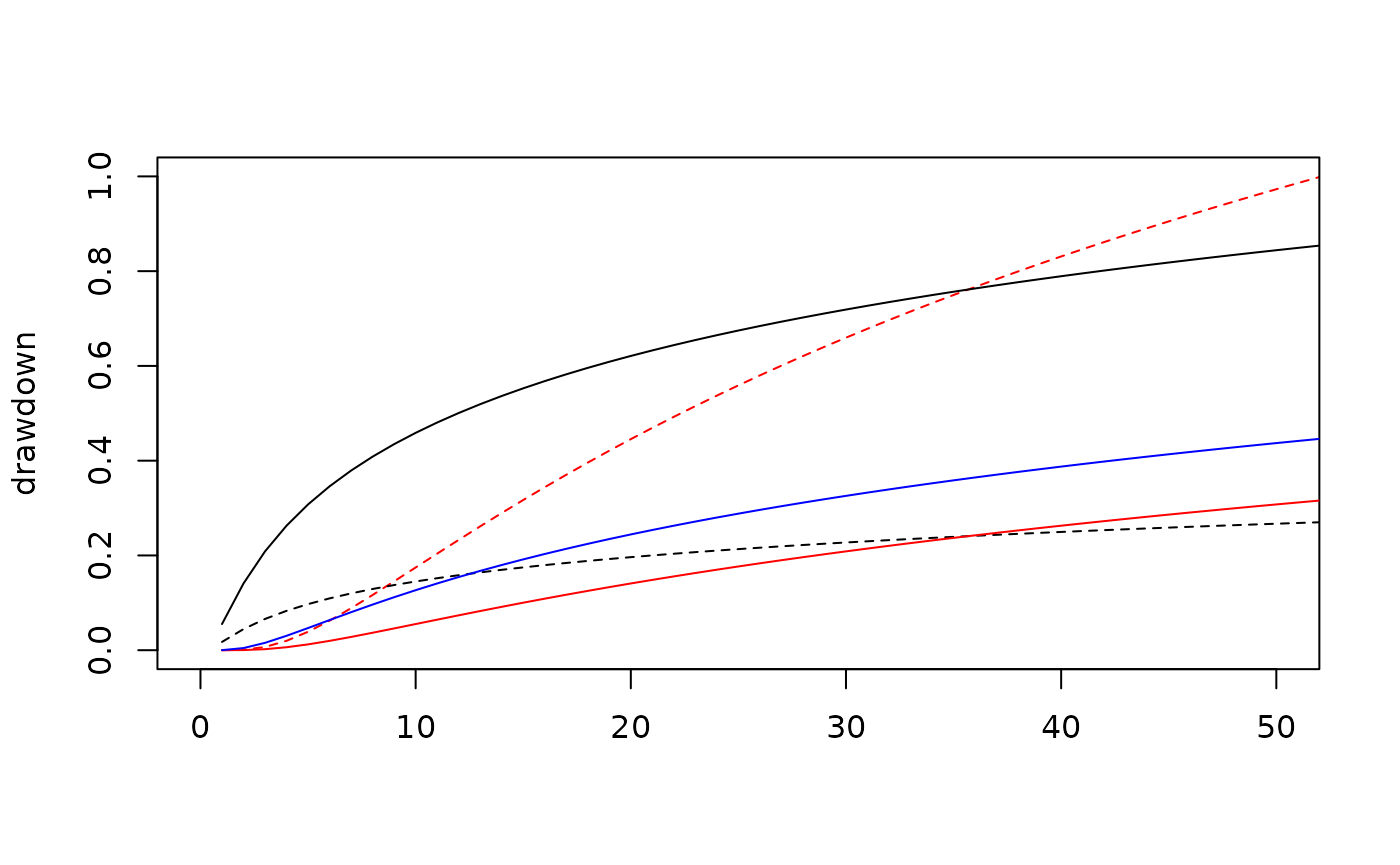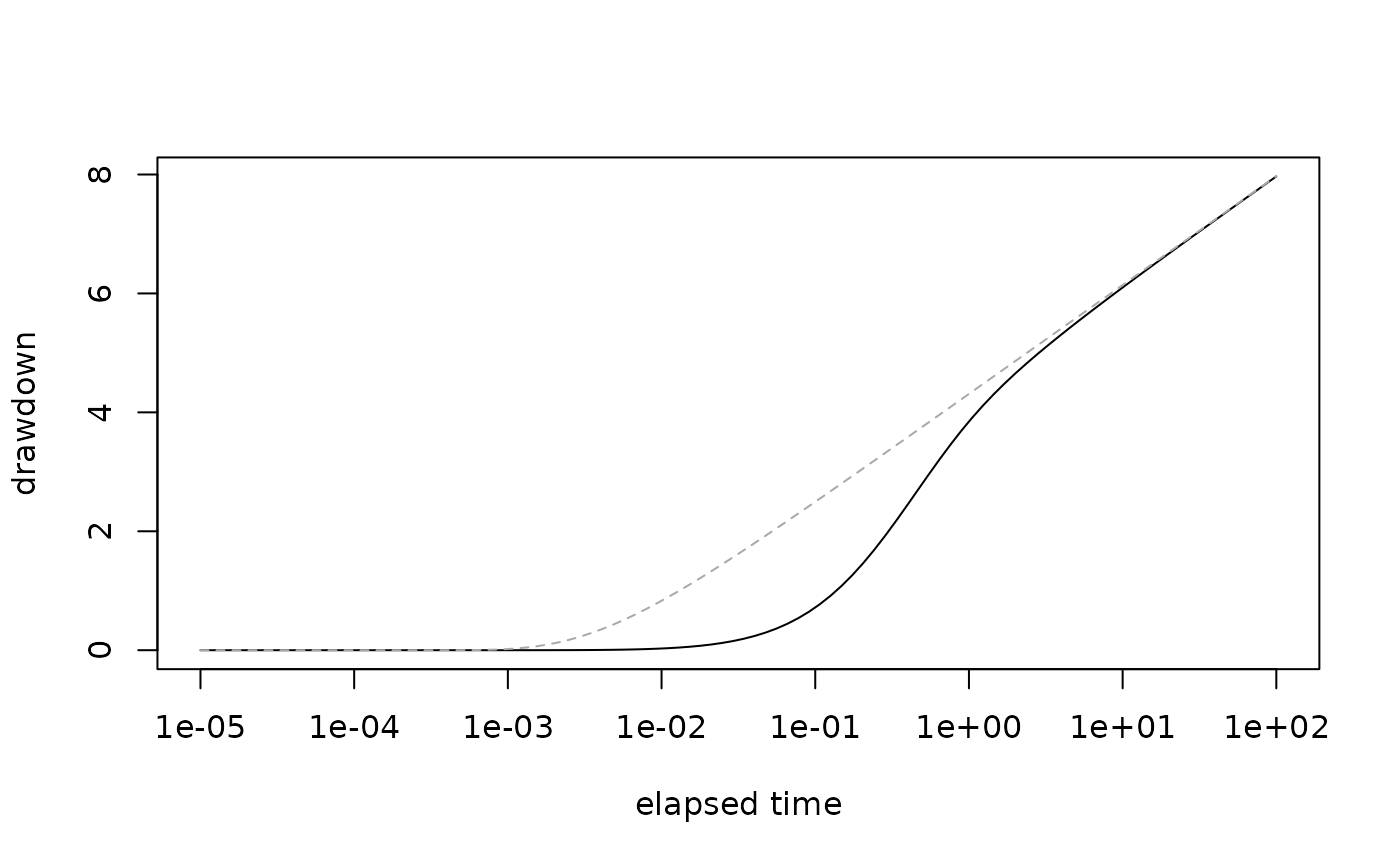Aquifer steps
aquifer.RmdGeneralized radial flow model (Barker, 1988)
time <- as.numeric(1:2000)
flow_rate <- c(rep(0.001, 500),
rep(0.002, 500),
rep(0.0, 1000))
# radial (flow_dimension = 2 Theis)
dat <- data.frame(time = time,
flow_rate = flow_rate)
formula <- as.formula(flow_rate~time)
grf = recipe(formula = formula, data = dat) |>
step_aquifer_grf(time = time,
flow_rate = flow_rate,
thickness = 1.0,
radius = 20.0,
specific_storage = 1e-5,
hydraulic_conductivity = 1e-3,
flow_dimension = 2) |>
plate()
#> a: 0
plot(aquifer_grf~time, grf,
type = "l",
ylab = "drawdown",
xlab = "")
Anisotropic Theis flow model (Papadopulos, 1965)
# along major direction
theis_aniso_x <- recipe(formula = formula, data = dat) |>
step_aquifer_theis_aniso(time = time,
flow_rate = flow_rate,
thickness = 1.0,
distance_x = 20,
distance_y = 0,
specific_storage = 1e-5,
hydraulic_conductivity_major = 1.0e-3,
hydraulic_conductivity_minor = 1.0e-4,
major_axis_angle = 0.0) |>
plate()
# along minor direction
theis_aniso_y <- recipe(formula = formula, data = dat) |>
step_aquifer_theis_aniso(time = time,
flow_rate = flow_rate,
thickness = 1.0,
distance_x = 0,
distance_y = 20,
specific_storage = 1e-5,
hydraulic_conductivity_major = 1.0e-3,
hydraulic_conductivity_minor = 1.0e-4,
major_axis_angle = 0.0) |>
plate()
# midway between minor and major
theis_aniso_xy <- recipe(formula = formula, data = dat) |>
step_aquifer_theis_aniso(time = time,
flow_rate = flow_rate,
thickness = 1.0,
distance_x = 20 / (sqrt(2)),
distance_y = 20 / (sqrt(2)),
specific_storage = 1e-5,
hydraulic_conductivity_major = 1.0e-3,
hydraulic_conductivity_minor = 1.0e-4,
major_axis_angle = 0.0) |>
plate()
# isotropic higher K
theis_aniso_iso_high <- recipe(formula = formula, data = dat) |>
step_aquifer_theis_aniso(time = time,
flow_rate = flow_rate,
thickness = 1.0,
distance_x = 20,
distance_y = 0,
specific_storage = 1e-5,
hydraulic_conductivity_major = 1.0e-3,
hydraulic_conductivity_minor = 1.0e-3,
major_axis_angle = 0.0) |>
plate()
# isotropic lower K
theis_aniso_iso_low <- recipe(formula = formula, data = dat) |>
step_aquifer_theis_aniso(time = time,
flow_rate = flow_rate,
thickness = 1.0,
distance_x = 20,
distance_y = 0,
specific_storage = 1e-5,
hydraulic_conductivity_major = 1.0e-4,
hydraulic_conductivity_minor = 1.0e-4,
major_axis_angle = 0.0) |>
plate()
plot(aquifer_theis_aniso~time, theis_aniso_iso_low,
type = "l",
ylab = "drawdown",
xlab = "",
lty = 2,
col = "red")
points(aquifer_theis_aniso~time, theis_aniso_iso_high,
type = "l",
ylab = "drawdown",
xlab = "",
lty = 2)
points(aquifer_theis_aniso~time, theis_aniso_x,
type = "l",
ylab = "drawdown",
xlab = "")
points(aquifer_theis_aniso~time, theis_aniso_y,
type = "l",
ylab = "drawdown",
xlab = "",
col = "red")
points(aquifer_theis_aniso~time, theis_aniso_xy,
type = "l",
ylab = "drawdown",
xlab = "",
col = "blue")
# Early time
plot(aquifer_theis_aniso~time, theis_aniso_iso_low,
type = "l",
ylab = "drawdown",
xlab = "",
lty = 2,
xlim = c(0, 50),
ylim = c(0, 1),
col = "red")
points(aquifer_theis_aniso~time, theis_aniso_iso_high,
type = "l",
ylab = "drawdown",
xlab = "",
lty = 2)
points(aquifer_theis_aniso~time, theis_aniso_x,
type = "l",
ylab = "drawdown",
xlab = "")
points(aquifer_theis_aniso~time, theis_aniso_y,
type = "l",
ylab = "drawdown",
xlab = "",
col = "red")
points(aquifer_theis_aniso~time, theis_aniso_xy,
type = "l",
ylab = "drawdown",
xlab = "",
col = "blue")
Hantush-Jacob leaky aquifer (Hantush-Jacob, 1955)
# high
hj <- recipe(formula = formula, data = dat) |>
step_aquifer_leaky(time,
flow_rate,
leakage = 100,
radius = 100,
storativity = 1e-6,
transmissivity = 1e-4) |>
plate()
plot(aquifer_leaky~time, hj, type = "l",
ylab = "drawdown",
xlab = "")
Barker-Herbert radially symmetric patch (Barker-Herbert, 1982)
Figure 2
formula <- as.formula(flow_rate~time)
q <- 0.05
t_1 <- 1.0
t_2 <- 1.0
s_1 <- 1e-5
s_2 <- 1e-7
r <- 10
R <- 100
time <- 10^seq(-4, 4, 0.01)
dat <- data.frame(time = time)
bh = recipe(formula = formula, data = dat) |>
step_aquifer_patch(time = time,
flow_rate = q,
thickness = 1.0,
radius = r,
radius_patch = R,
specific_storage_inner = s_1,
specific_storage_outer = s_2,
hydraulic_conductivity_inner = t_1,
hydraulic_conductivity_outer = t_2,
n_stehfest = 12L) |>
plate()
dim_time_scale = (4.0 * t_1) / (s_1 * r^2)
dim_s_scale = 4.0 * pi * t_1 / q
bh$dim_time <- bh$time * dim_time_scale
bh$dim_s <- bh$aquifer_patch * dim_s_scale
plot(dim_s~dim_time, bh, type = "l",
ylab = "drawdown (dimensionless)",
xlab = "time (dimensionless)",
log = "x",
ylim = c(0, 50))
bh = recipe(formula = formula, data = dat) |>
step_aquifer_patch(time = time,
flow_rate = q,
thickness = 1.0,
radius = r,
radius_patch = R,
specific_storage_inner = s_1,
specific_storage_outer = s_2,
hydraulic_conductivity_inner = t_1,
hydraulic_conductivity_outer = t_2 * 10,
n_stehfest = 12L) |>
plate()
dim_time_scale = (4.0 * t_1) / (s_1 * r^2)
dim_s_scale = 4.0 * pi * t_1 / q
bh$dim_time <- bh$time * dim_time_scale
bh$dim_s <- bh$aquifer_patch * dim_s_scale
points(dim_s~dim_time, bh, type = "l")
t_1 <- t_1 * 10.0
bh = recipe(formula = formula, data = dat) |>
step_aquifer_patch(time = time,
flow_rate = q,
thickness = 1.0,
radius = r,
radius_patch = R,
specific_storage_inner = s_1,
specific_storage_outer = s_2,
hydraulic_conductivity_inner = t_1,
hydraulic_conductivity_outer = t_2,
n_stehfest = 12L) |>
plate()
dim_time_scale = (4.0 * t_1) / (s_1 * r^2)
dim_s_scale = (4.0 * pi * t_1) / q
bh$dim_time <- bh$time * dim_time_scale
bh$dim_s <- bh$aquifer_patch * dim_s_scale
points(dim_s~dim_time, bh, type = "l")
Figure 3
formula <- as.formula(flow_rate~time)
t_1 <- 1.0
t_2 <- 1.0
s_1 <- 1e-5
s_2 <- 1e-5
bh = recipe(formula = formula, data = dat) |>
step_aquifer_patch(time = time,
flow_rate = q,
thickness = 1.0,
radius = r,
radius_patch = R,
specific_storage_inner = s_1,
specific_storage_outer = s_2,
hydraulic_conductivity_inner = t_1,
hydraulic_conductivity_outer = t_2,
n_stehfest = 12L) |>
plate()
dim_time_scale = (4.0 * t_1) / (s_1 * r^2)
dim_s_scale = 4.0 * pi * t_1 / q
bh$dim_time <- bh$time * dim_time_scale
bh$dim_s <- bh$aquifer_patch * dim_s_scale
plot(dim_s~dim_time, bh, type = "l",
ylab = "drawdown (dimensionless)",
xlab = "time (dimensionless)",
log = "x",
ylim = c(0, 50))
bh = recipe(formula = formula, data = dat) |>
step_aquifer_patch(time = time,
flow_rate = q,
thickness = 1.0,
radius = r,
radius_patch = R,
specific_storage_inner = s_1,
specific_storage_outer = s_2,
hydraulic_conductivity_inner = t_1,
hydraulic_conductivity_outer = t_2 * 10,
n_stehfest = 12L) |>
plate()
dim_time_scale = (4.0 * t_1) / (s_1 * r^2)
dim_s_scale = 4.0 * pi * t_1 / q
bh$dim_time <- bh$time * dim_time_scale
bh$dim_s <- bh$aquifer_patch * dim_s_scale
points(dim_s~dim_time, bh, type = "l")
t_1 <- t_1 * 10.0
bh = recipe(formula = formula, data = dat) |>
step_aquifer_patch(time = time,
flow_rate = q,
thickness = 1.0,
radius = r,
radius_patch = R,
specific_storage_inner = s_1,
specific_storage_outer = s_2,
hydraulic_conductivity_inner = t_1,
hydraulic_conductivity_outer = t_2,
n_stehfest = 12L) |>
plate()
dim_time_scale = (4.0 * t_1) / (s_1 * r^2)
dim_s_scale = (4.0 * pi * t_1) / q
bh$dim_time <- bh$time * dim_time_scale
bh$dim_s <- bh$aquifer_patch * dim_s_scale
points(dim_s~dim_time, bh, type = "l")
Figure 4
formula <- as.formula(flow_rate~time)
q <- 0.05
t_1 <- 1.0
t_2 <- 1.0
s_1 <- 1e-5
s_2 <- 1e-5
r <- 100
R <- 90
bh = recipe(formula = formula, data = dat) |>
step_aquifer_patch(time = time,
flow_rate = q,
thickness = 1.0,
radius = r,
radius_patch = R,
specific_storage_inner = s_1,
specific_storage_outer = s_2,
hydraulic_conductivity_inner = t_1,
hydraulic_conductivity_outer = t_2,
n_stehfest = 14L) |>
plate()
dim_time_scale = (4.0 * t_1) / (s_2 * r^2)
dim_s_scale = 4.0 * pi * t_2 / q
bh$dim_time <- bh$time * dim_time_scale
bh$dim_s <- bh$aquifer_patch * dim_s_scale
plot(dim_s~dim_time, bh, type = "l",
ylab = "drawdown (dimensionless)",
xlab = "time (dimensionless)",
log = "x",
ylim = c(0, 10))
bh = recipe(formula = formula, data = dat) |>
step_aquifer_patch(time = time,
flow_rate = q,
thickness = 1.0,
radius = r,
radius_patch = R,
specific_storage_inner = s_1,
specific_storage_outer = s_2,
hydraulic_conductivity_inner = t_1,
hydraulic_conductivity_outer = t_2 * 10,
n_stehfest = 14L) |>
plate()
dim_time_scale = (4.0 * t_2 * 10) / (s_1 * r^2)
dim_s_scale = 4.0 * pi * t_2 * 10 / q
bh$dim_time <- bh$time * dim_time_scale
bh$dim_s <- bh$aquifer_patch * dim_s_scale
points(dim_s~dim_time, bh, type = "l")
bh = recipe(formula = formula, data = dat) |>
step_aquifer_patch(time = time,
flow_rate = q,
thickness = 1.0,
radius = r,
radius_patch = R,
specific_storage_inner = s_1,
specific_storage_outer = s_2,
hydraulic_conductivity_inner = t_1 * 10,
hydraulic_conductivity_outer = t_2,
n_stehfest = 14L) |>
plate()
dim_time_scale = (4.0 * t_2) / (s_1 * r^2)
dim_s_scale = (4.0 * pi * t_2) / q
bh$dim_time <- bh$time * dim_time_scale
bh$dim_s <- bh$aquifer_patch * dim_s_scale
points(dim_s~dim_time, bh, type = "l")
Papadopulos-Cooper wellbore storage(Papadopulos-Cooper, 1967)
dat <- data.frame(time = 10^seq(-5, 2, length.out = 100),
flow_rate = rep(10.0, 100))
formula <- as.formula(flow_rate~time)
pc = recipe(formula = formula, data = dat) |>
step_aquifer_wellbore_storage(time = time,
flow_rate = 10.0,
radius = 10.0,
radius_casing = 0.3,
radius_well = 0.3,
thickness = 1.0,
specific_storage = 1e-4,
hydraulic_conductivity = 1.0,
n_terms = 12L) |>
plate()
th <- recipe(time~flow_rate, dat) |>
step_aquifer_grf(time = time,
flow_rate = flow_rate,
thickness = 1.0,
radius = 10.0,
specific_storage = 1e-4,
hydraulic_conductivity = 1.0,
flow_dimension = 2.0) |>
plate()
#> a: 0
plot(aquifer_wellbore_storage~time, pc,
type = "l",
log = "x",
ylab = "drawdown",
xlab = "elapsed time")
points(aquifer_grf~time, th, type = "l", col = "darkgrey", lty = "dashed")
Jacob-Lohman constant drawdown (Jacob-Lohman, 1952)
time <- 10^seq(-5, 2, 0.1)
form <- formula(time~.)
dat <- data.frame(time = time)
jl = recipe(formula = form, data = dat) |>
step_aquifer_constant_drawdown(time = time,
drawdown = 10,
thickness = 10,
radius_well = 0.15,
specific_storage = 1e-6,
hydraulic_conductivity = 1) |>
plate()
plot(aquifer_constant_drawdown~time, jl, type = "l",
ylab = "flow rate",
xlab = "elapsed time",
log = "x")
References
Barker, J.A., A generalized radial flow model for hydraulic tests in fractured rock. Water Resour. Res., 24 (1988), pp. 1796-1804, 10.1029/WR024i010p01796
Barker, J.A., and R. Herbert, 1982: Pumping tests in patchy aquifers, Ground Water, vol. 20, No. 2, pp. 150-155.
Butler, J.J., 1988: Pumping tests in nonuniform aquifers – The radially symmetric case, Journal of Hydrology, Vol. 101, pp. 15-30.
Hantush, M.S. and C.E. Jacob, 1955. Non-steady radial flow in an infinite leaky aquifer, Am. Geophys. Union Trans., vol. 36, no. 1, pp. 95-100.
Heilweil, V.M. and Hsieh, P.A., 2006. Determining anisotropic transmissivity using a simplified Papadopulos method. Groundwater, 44(5), pp.749-753.
Jacob, C.E. and S.W. Lohman, 1952. Nonsteady flow to a well of constant drawdown in an extensive aquifer, Trans. Am. Geophys. Union, vol. 33, pp. 559-569.
Papadopulos, I.S., 1965. Nonsteady flow to a well in an infinite anisotropic aquifer.
Papadopulos, I.S. and H.H. Cooper, 1967. Drawdown in a well of large diameter, Water Resources Research, vol. 3, no. 1, pp. 241-244.
Prodanoff, J.H.A., Mansur, W.J. and Mascarenhas, F.C.B., 2006. Numerical evaluation of Theis and Hantush-Jacob well functions. Journal of hydrology, 318(1-4), pp.173-183.
sessionInfo()
#> R version 4.5.0 (2025-04-11)
#> Platform: x86_64-pc-linux-gnu
#> Running under: Ubuntu 24.04.2 LTS
#>
#> Matrix products: default
#> BLAS: /usr/lib/x86_64-linux-gnu/openblas-pthread/libblas.so.3
#> LAPACK: /usr/lib/x86_64-linux-gnu/openblas-pthread/libopenblasp-r0.3.26.so; LAPACK version 3.12.0
#>
#> locale:
#> [1] LC_CTYPE=C.UTF-8 LC_NUMERIC=C LC_TIME=C.UTF-8
#> [4] LC_COLLATE=C.UTF-8 LC_MONETARY=C.UTF-8 LC_MESSAGES=C.UTF-8
#> [7] LC_PAPER=C.UTF-8 LC_NAME=C LC_ADDRESS=C
#> [10] LC_TELEPHONE=C LC_MEASUREMENT=C.UTF-8 LC_IDENTIFICATION=C
#>
#> time zone: UTC
#> tzcode source: system (glibc)
#>
#> attached base packages:
#> [1] stats graphics grDevices utils datasets methods base
#>
#> other attached packages:
#> [1] hydrorecipes_0.0.6 Bessel_0.6-1
#>
#> loaded via a namespace (and not attached):
#> [1] gmp_0.7-5 plotly_4.10.4 sass_0.4.10 generics_0.1.3
#> [5] tidyr_1.3.1 lattice_0.22-6 digest_0.6.37 magrittr_2.0.3
#> [9] evaluate_1.0.3 grid_4.5.0 fastmap_1.2.0 jsonlite_2.0.0
#> [13] Matrix_1.7-3 httr_1.4.7 purrr_1.0.4 viridisLite_0.4.2
#> [17] scales_1.3.0 lazyeval_0.2.2 textshaping_1.0.0 jquerylib_0.1.4
#> [21] cli_3.6.5 RcppThread_2.2.0 Rmpfr_1.0-0 rlang_1.1.6
#> [25] munsell_0.5.1 cachem_1.1.0 yaml_2.3.10 tools_4.5.0
#> [29] parallel_4.5.0 dplyr_1.1.4 colorspace_2.1-1 ggplot2_3.5.2
#> [33] earthtide_0.1.7 vctrs_0.6.5 R6_2.6.1 lifecycle_1.0.4
#> [37] gslnls_1.4.1 fs_1.6.6 htmlwidgets_1.6.4 ragg_1.4.0
#> [41] pkgconfig_2.0.3 desc_1.4.3 pkgdown_2.1.1 bslib_0.9.0
#> [45] pillar_1.10.2 gtable_0.3.6 data.table_1.17.0 glue_1.8.0
#> [49] Rcpp_1.0.14 systemfonts_1.2.2 collapse_2.1.1 xfun_0.52
#> [53] tibble_3.2.1 tidyselect_1.2.1 knitr_1.50 htmltools_0.5.8.1
#> [57] rmarkdown_2.29 compiler_4.5.0